
Hemichordata. Bateson, 1885; Stomochorda. Dawydoff, 1948. They first appeared in the early or middle Cambrian period. Hemichordates are exclusively marine, benthic, soft-bodied animals belonging to the Deuterostomia group. They are characterized by the commonality of the initial stages of embryonic development, the presence of a notochord (a dorsal outgrowth of the gut, also known as a stomochord), the unique structure of the secondary body cavity, and perforating budding. Hemichordates share many of the same characteristics as chordates, with the name hemichordate roughly translating to “half a chordate”.
Some of them have a worm-like body shape and lead a free lifestyle, burrowing in muddy bottom sediments. Others are sessile, attached animals that can form peculiar colonies.
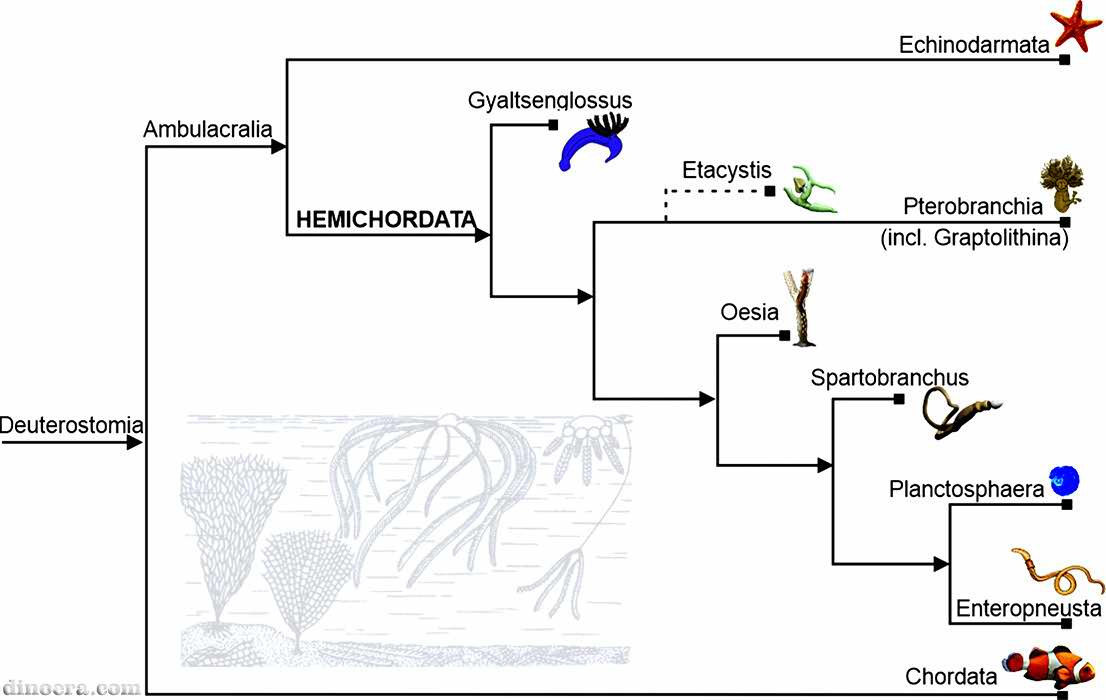
Hemichordata phylogeny
In the evolutionary tree, Hemichordates are at the very base of the chordate group. Their wide distribution, both in shallow coastal waters and in marine depths, suggests that Hemichordata were an important component of many Cambrian communities.

Graptolithes
Outside the Cambrian period, hemichordates have a poor fossil record because these soft-bodied organisms lacked skeletal elements, making their fossils extremely rare. In the fossilized state, the collagenous tubes of pterobranchs are the most widely distributed, and among them, graptolithes are particularly well-known. They are often used for correlating rock formations.
In the Middle Cambrian, colonial pterobranchs living in tubes coexisted with enteropneusts, which also inhabited tubes. This supports the idea that a common body plan for hemichordates had already emerged earlier in the Cambrian period.
Hemichordates are characterized by bilateral symmetry and triploblastic (three-part) body organization. In the anterior part, there is the prosome or preoral lobe (proboscis in enteropneusts or head shield in pterobranchs), followed by the intermediate mesosome (collar), and the posterior part is the metasome (body).
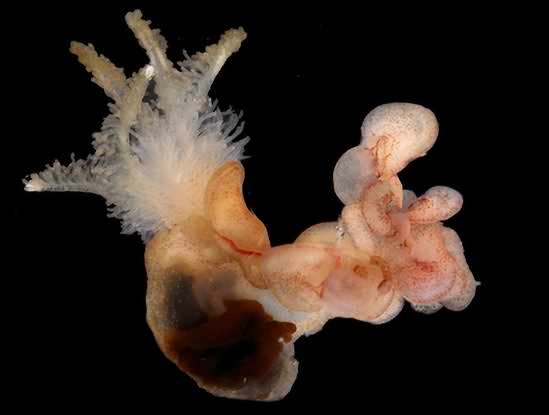
Cephalodiscus densus (Pterobranchia)
Hemichordates have a stomochord rather than a true notochord. The stomochord, a blind diverticulum of the intestine, supports the proboscis in the anterior part. The stomochord was previously considered to be homologous to the notochord in chordates, but it is more likely the result of convergent evolution rather than homology.
Some species have a dorsal nerve cord that develops similarly to other chordates, but hardens only in adult individuals. This is likely a primitive feature they share with the common ancestor of chordates and other deuterostomes. However, they also have a ventral nerve cord, similar to arthropods. Both nerve cords are connected by a nerve ring located between the body and the collar. The central nervous system of hemichordates is partially homologous to the nerve tube found in chordates.
The circulatory system is open in hemichordates. It consists of two vessels — the abdominal and dorsal vessels, with a pericardium attached to the dorsal vessel, which is a dorsal pulsating muscular organ. The circulatory system of hemichordates is similar to the circulatory systems of other invertebrates, such as arthropods and mollusks. Some species are capable of producing calcium carbonate through biomineralization processes.

Ptychodera flava (Enteropneusta)
Respiration in Hemichordates is carried out through breathing openings or several pairs of gill slits. Longitudinal sections of the paired gill bars closely resemble those of early chordates. Due to the similarity in the structure of the gill slits, hemichordates were initially classified within the Protochordata group. However, it later became known that, genetically, they are more similar to echinoderms than chordates. Therefore, they were assigned their own separate phylum. Hemichordates are the closest living phylogenetic relatives of chordates among invertebrates today. Hence, they are of significant interest in studying the origins of chordate development.
Hemichordates are dioecious, with external fertilization, but they can also reproduce through budding. The notable resemblance between tornaria larvae (larvae of hemichordates) and bipinnaria larvae (larvae of echinoderms) suggests that hemichordates can be considered a transitional link between echinoderms and chordate animals.
Together with echinoderms, hemichordates form the clade Ambulacraria, which is the sister group to chordates. Xenoturbellida may be basal within this group. It is hypothesized that the extinct organism Etacystis communis (Pennsylvanian) is a representative of Hemichordata in the Pterobranchia or closely related to them. However, it is also possible that it belongs to the Siphonophorae (Hydrozoa).
Hemichordata is divided into two classes: Enteropneusta, commonly known as acorn worms, and Pterobranchia, to which the extinct class Graptolithina belongs. A third class, Planctosphaeroidea, has been proposed based on a single species known only from larvae. Currently, there are approximately 130 species of hemichordates in existence.
Oesia disjuncta

A Life reconstruction Oesia disjuncta with hypothetical closed terminal ends of the tubes — part of one tube partially removed to show a worm. ©Marianne Collins
† Oesia disjuncta. Walcott, 1911. Middle Cambrian (Wuliuan), approximately 507 million years ago; Burgess Shale (Walcott Quarry, Raymond Quarry), and Marbel Canyon Site in Kootenay National Park, located 40 km from Burgess. From the Greater Phyllopod Bed layer (Walcott Quarry Member — Fossil Ridge), 1,147 specimens of Oesia are known, and in Marble Canyon, there are 3,373 specimens. It is a monospecific genus.
Etymology: Oesia — from Lake Oesa, a small lake located a few kilometers southeast of the Burgess Shale; disjuncta — from the Latin prefix dis, to signify a negation, and junctus, “joined.” The name is probably about the crooked or bent shape of the early discovered specimens of Oesia.

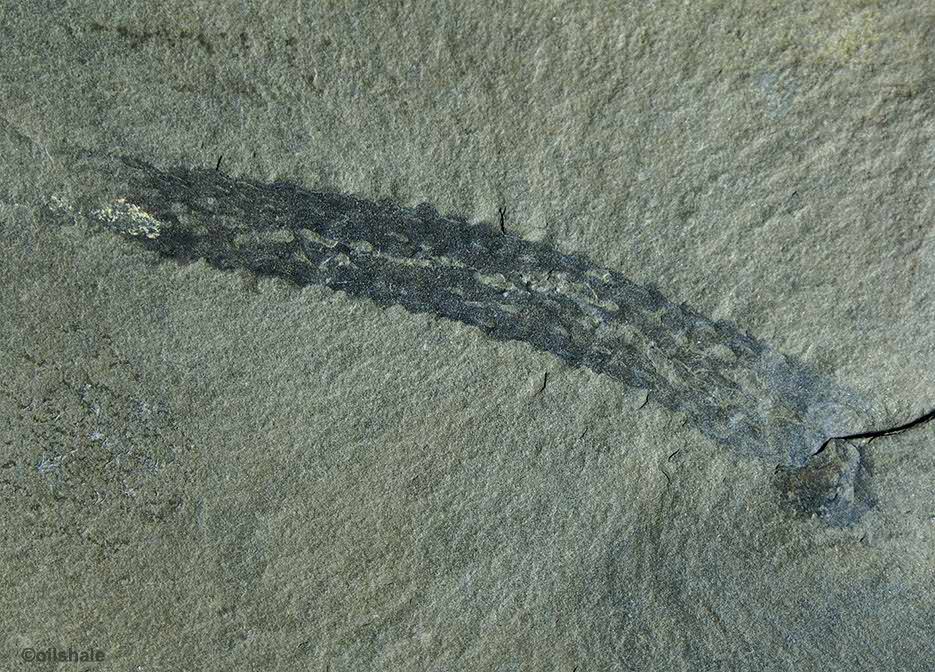
On the bottom of the Cambrian sea, delicate vertical towers with numerous openings were discovered. At that time, they were considered to be fossilized remains of alcyonarian corals or thallus of ancient algae and were named Margaretia dorus.

Hemichordata. A, B – Spirally arranged pores perforate the tube. D, E – Tube showing three-dimensional preservation. D – Large section of the tube has been broken off revealing the other side of the tube. E – The broken segment has been placed back in its original configuration to illustrate the three-dimensionality of the tube. ©Nanglu et al

In the same place, an ancient worm-like creature was found, which was named Oesia disjuncta. Over time, researchers discovered tubes containing this worm-like creature. It turned out that this worm was the one who built these tubes with oval, round, or rhombic holes, which were initially mistaken for algae. These perforated collagenous tubes evidently served as protection for the animals against predators. They were twice as wide as the creature’s body and significantly longer, suggesting that the worm could move freely within its dwelling. The tube could have several branches. The construction of a large and complex tube corresponds to a sessile lifestyle. Given that the pores were present on all sides, it is evident that the tube stood vertically.

Note the bilobed structure at the rear and extended pharyngeal area. ©Nanglu et al

Schematic anatomy of Oesia disjuncta. Co: collar, Cr: circum-collar ridge, Dg: digestive groove, Pr: proboscis, Hks: heart-kidney-stomochord complex, Gb: gill bars, Gp: gill pores, Mo: mouth, Po: pores, Ps: posterior structure, Tr: trunk, Tu: tube. Dashed lines indicate transverse cross sections. ©Nanglu et al
Oesia disjuncta was a filter feeder, utilizing rows of curved U-shaped gill slits along its entire body. The gill arches were covered with fine hair-like structures called cilia, which moved, creating a water flow towards the mouth. Oesia reached an average length of 53 mm, with a maximum of 120 mm in length and a diameter of 10 mm. Its elongated body had an oval proboscis and a collar that covered the mouth, located at one end of the body, while horizontal extensions were present at the other end, allowing the animal to attach itself to the substrate. The long, cylindrical body had an approximately uniform width throughout its length. Based on fossil impressions, it appears that only one individual occupied each tube. The characteristics of Oesia suggest that it is a basal acorn worm and the earliest known representative of the hemichordate phylum.
Synonyms: Margaretia dorus.
Gyaltsenglossus senis

Reconstruction of Gyaltsenglossus senis. The image in the foreground shows Gyaltsenglossus as it would appear while motile. The background illustrates the posture of the animal while attached to the seafloor and suspension feeding. © Royal Ontario Museum, Emily S. Damstra
† Gyaltsenglossus senis. Pronounced “Gen-zay”. The name is in honor of K. Nanglu’s father, and the rest of the name means “old tongue”. Early Middle Cambrian, approximately 506 million years ago, in the Burgess Shale (Odaray Mountain, British Columbia). 33 specimens have been found here. It belongs to the basal hemichordates. It reached a length of 1.5–2.0 cm.

Gyaltsenglossus senis Holotype. Most complete specimen, showing full length of the proboscis, six feeding arms, a cluster of thin appendages located on the dorsal surface of the trunk, and the posterior structure with dark internal structures. ©Caron ©Nanglu et al
fa = feeding arms; is = internal structures; ps = posterior structure; pc = proboscis coelom; pr = proboscis; tr = trunk; ta = thin appendages
Gyaltsenglossus senis had an ovoid proboscis, similar to that of enteropneusts, and tentacles like those of pterobranchs. Six feeding arms extended from the dorsal region immediately behind the proboscis. These arms were thin, almost one and a half times longer than the proboscis, with the longest one measuring approximately 1 cm. About 15 pairs of symmetrical tentacles branched off from each arm. Behind the crowns of the feeding arms, a row of slender appendages protruded from a small, elevated platform. These thin appendages were considerably shorter than the feeding arms (about 0.25 cm) and lacked tentacles. The body was worm-like: the anterior end was approximately twice as wide as the posterior end. There was a post-anal convex attachment structure.
No evidence of tube-dwelling has been found. Gyaltsenglossus is considered to be a stem hemichordate.

Spartobranchus tenuis
† Spartobranchus tenuis. Walcott, 1911; Caron, Conway Morris, & Cameron, 2013. Middle Cambrian, 505 million years ago, Burgess Shale, Canada, British Columbia (Walcott Quarry in Yoho National Park). Spartobranchus tenuis had a flexible, worm-like body consisting of a short proboscis, a collar, and a narrow, elongated stalk ending in a thickened structure that could have served for attachment to a substrate. The length of the largest known specimen reached up to 10 cm, with the proboscis measuring about half a centimeter in length. They fed by filtering small food particles through their gill slits.
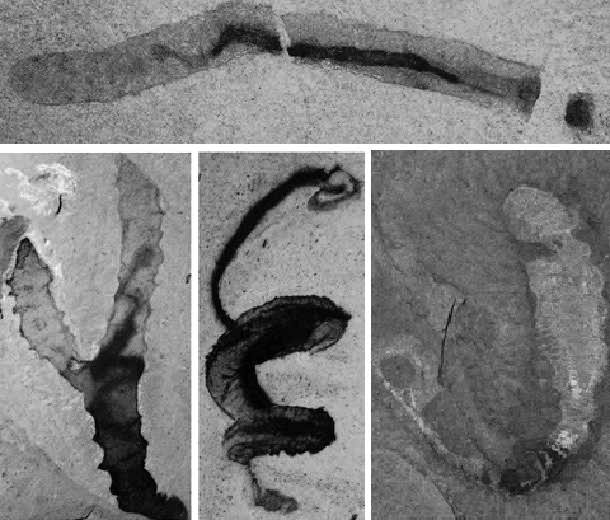
Spartobranchus tenuis individuals associated with tubular structures, from the Burgess Shale. Linear tube, Branching tube, Helicoidal tube, U-shaped tube. ©Cameron
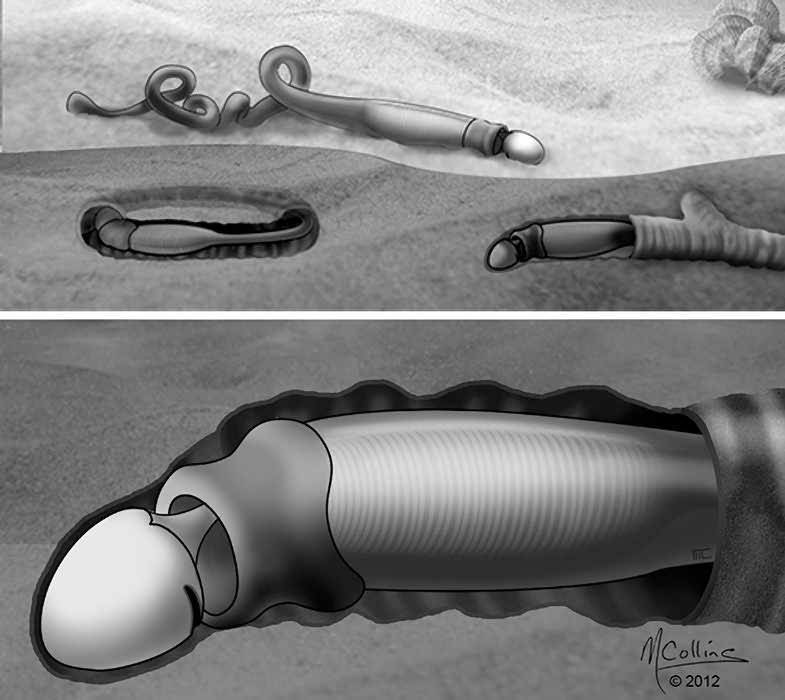
Spartobranchus tenuis ©Marianne Collins
The body shape of fossil Spartobranchus tenuis is similar to that of modern acorn worms. However, they inhabited fibrous tubes, a feature lost in modern Enteropneusta but still present in Pterobranchia. Some of these tubes were branched. Spartobranchus represents an evolutionary link between two groups of hemichordates: the acorn worms and the pterobranchs.
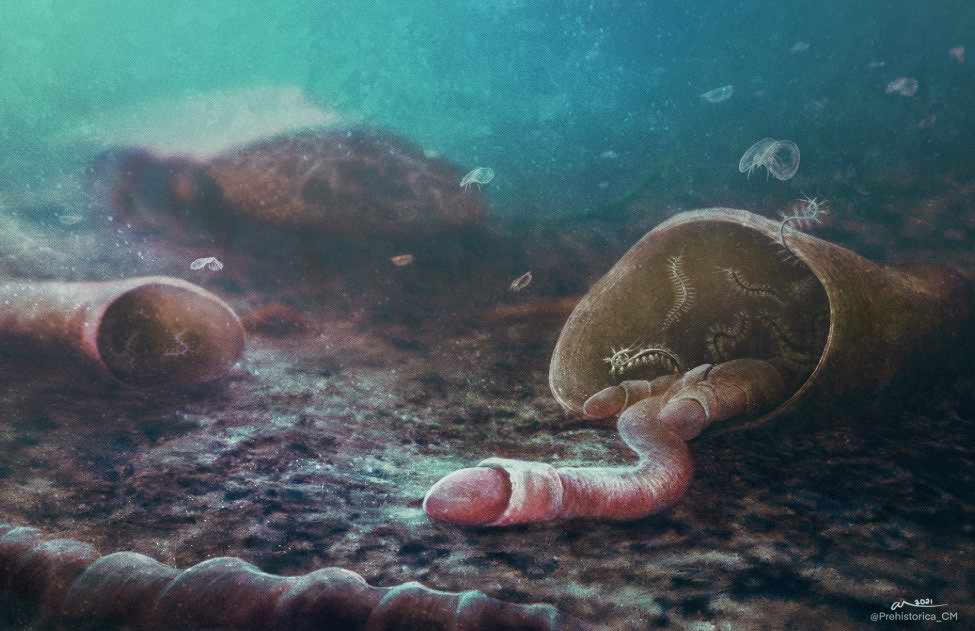
Reconstruction of Spartobranchus-like enteropneusts and polychaetes living inside large tubes. Christian McCall © Royal Ontario Museum
Family Planctosphaeridae
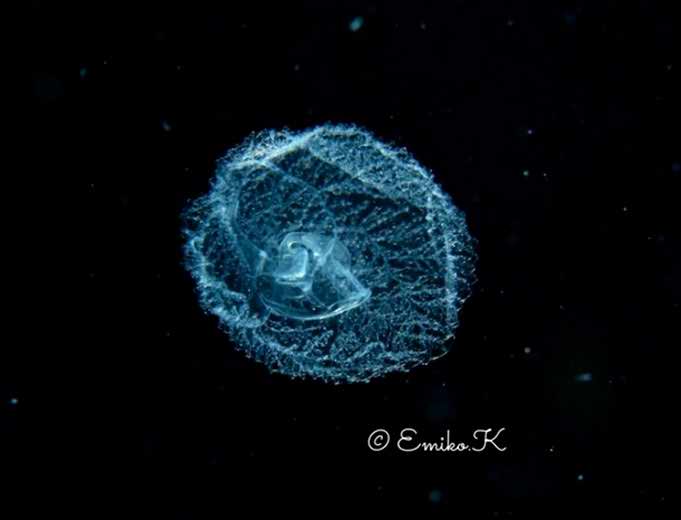
This group is sometimes classified into a separate class called Planctosphaeroidea and is unique in that it contains only one known extant species.
Planctosphaera pelagica. Pelagic Planctosphaera. Spengel, 1932. The only species. Diameter: 10–27 mm. It is found in the Pacific and Atlantic Oceans. Bilaterally symmetrical. It inhabits depths ranging from 75 to 1000 meters. This organism is only known from its small, spherical, transparent pelagic larva. Adult forms have not been observed. It has limited swimming abilities.

Planctosphaera pelagica
The bodies of these larvae are covered with extensively branched ciliary bands, which serve to capture food particles. The oral region of these animals occupies about 2/3 of their surface. They possess an L-shaped digestive tract. Due to the presence of mucus-secreting glands around the ciliary bands and the large size of the larvae, they are typically classified into a separate class. Since 1910, only around 30 discoveries have been made.













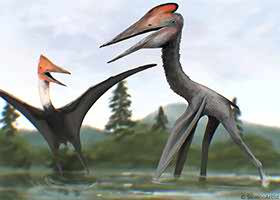
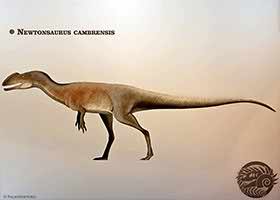
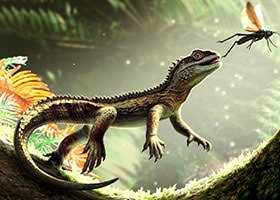
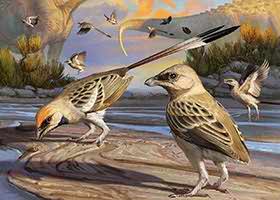
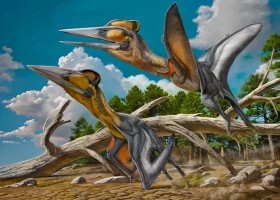




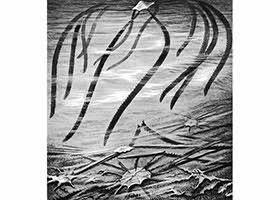
Graptolithes look like real aliens from outer space.